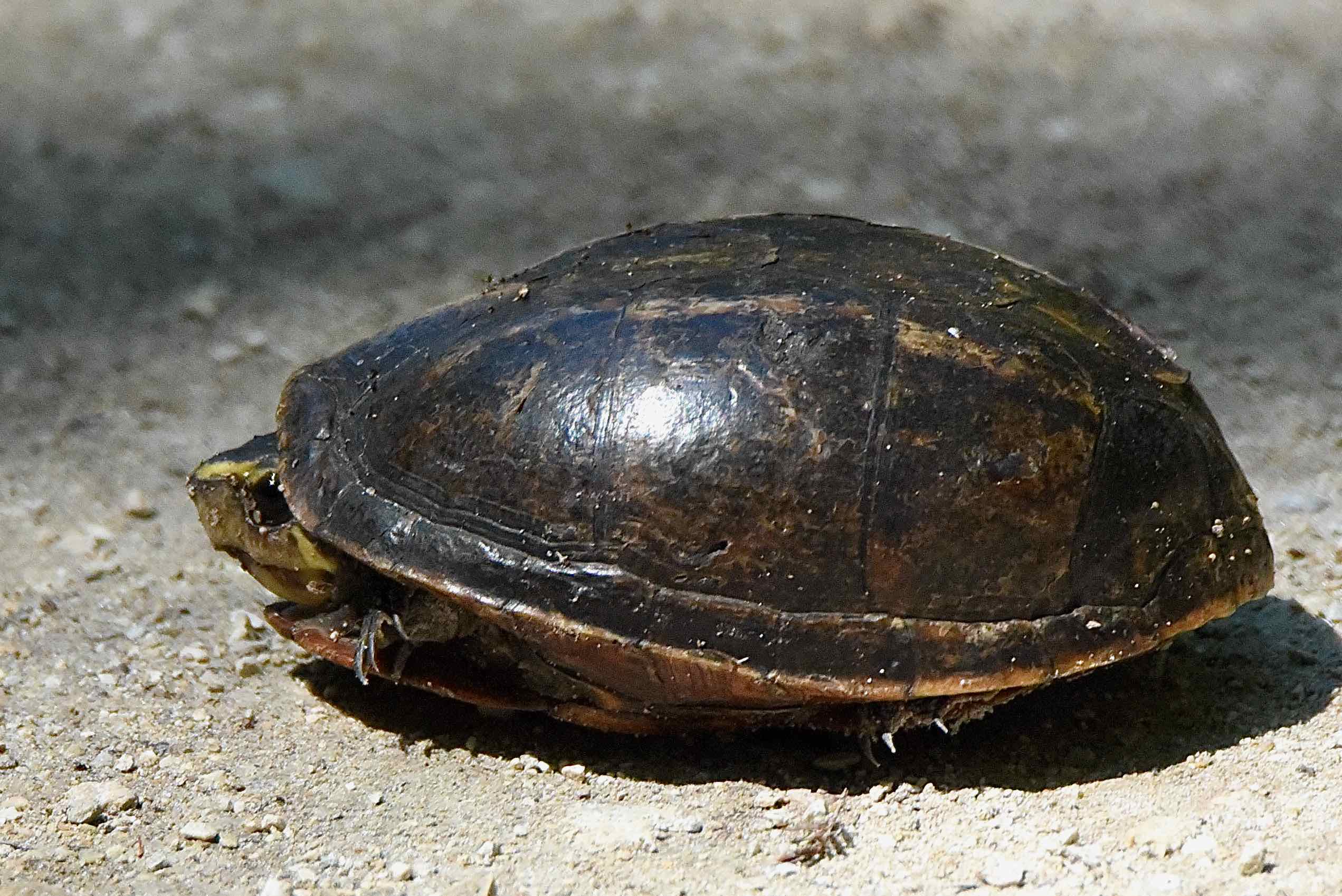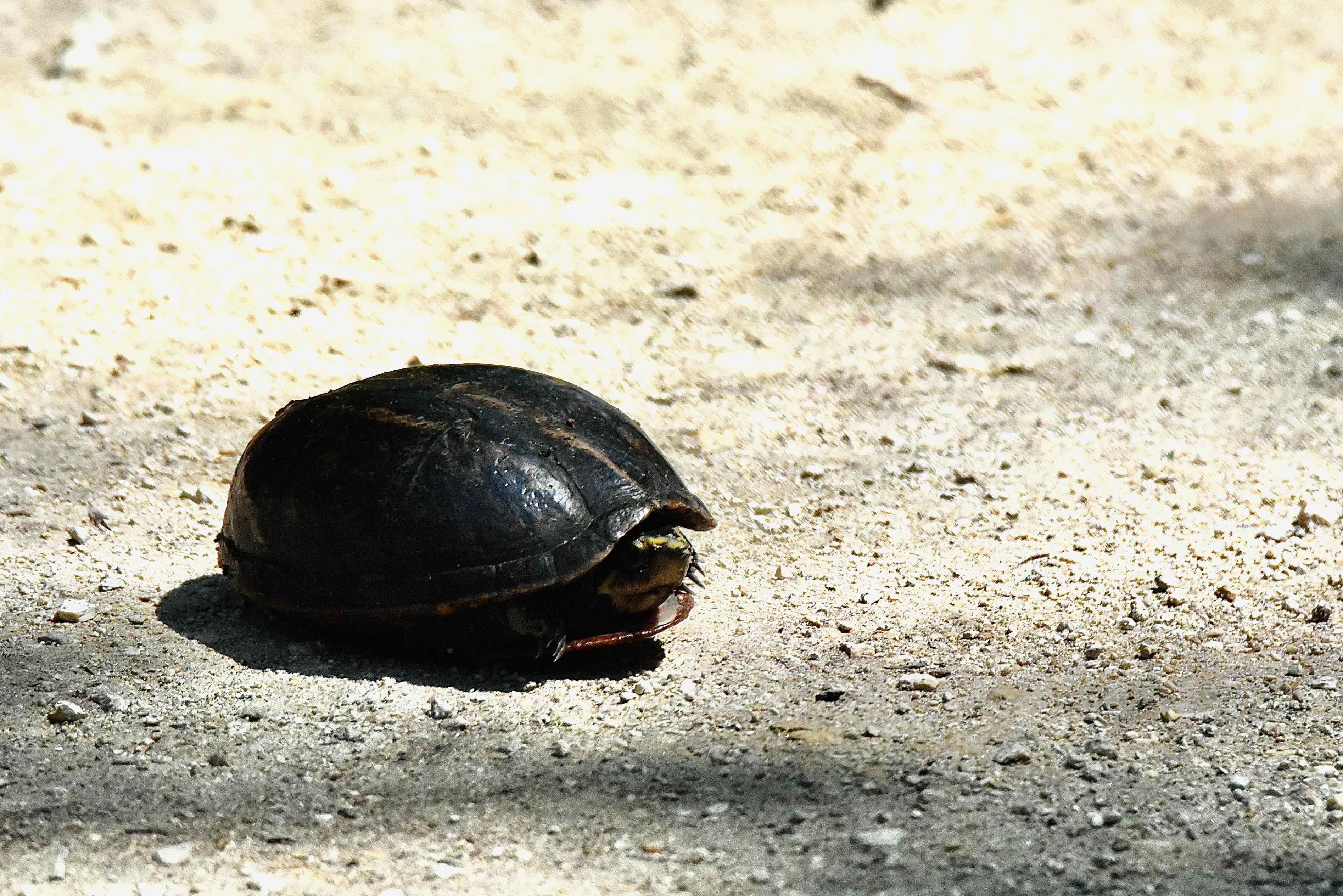
Striped mud turtle, photographed at Fakahatchee Strand Preserve State Park, Naples, Collier County, in May 2022.
You are looking at the smallest turtle found in the wilds of Florida, Kinosternon baurii, the striped mud turtle.
Its carapace, the shell that covers the back, typically is only four inches long, maybe five inches at most. To give you some idea how small the striped mud turtle is, consider the largest freshwater turtle found in Florida, the alligator snapping turtle, can reach 30 inches long and weigh upwards of 250 pounds. We picked up the turtle shown on this page — it was in the middle of the road — and can tell you it doubtfully reached a pound.
Striped mud turtles are found throughout the Peninsula and into the Keys, taking to freshwater habitats, like slow-moving creeks, canals and rivers, ponds, lakes, swamps, marshes and ditches.
Striped mud turtles can live in brackish water, but have a limited tolerance for salt. If a body of water where they live begins to dry, potentially becoming saltier, they will move onto land and wait for rains to “refresh” their home.
Their limited tolerance for salt makes their future in Lower Keys precarious as the climate changes, sea levels rise and infiltrate the limited sources of fresh water. More on this in a bit.
Outside of Florida, striped mud turtles can be found along the Atlantic coastal plain as far north as Maryland and Delaware, south through Virginia, North Carolina and Georgia. Their discovery in Maryland and Delaware is relatively recent, though naturalists believe they’ve been there all along but had just gone unnoticed.
The carapace is oval-shaped, brown with three yellow stripes down its length. These stripes might not be visible, and on turtles from Georgia and the Carolinas, not there at all. There’s also two yellow stripes on each side of the face.
Males and females are largely similar; however, the guys have longer and thicker tails than the ladies of the species. Males are also slightly smaller overall than females.
Striped mud turtles are omnivores; their diet includes insects, worms, snails and algae. They’ll also scavenge dead fish.

They nest year round, with peaks in June and also in September into November. Females trudge considerable distances to find a suitable nesting site, laying as many as six clutches — typically four — per year, each with one to six eggs each. Like other turtles, the sex of the embryos is determined by the temperature of their part of the nest. If temperatures drop too low — less than 75 degrees — embryos will pause their development. It can take a year for the eggs to hatch.
Females become sexually mature at six years, males slightly younger. There’s no real data on the lifespan of striped mud turtles in the wild, but the average lifespan of captive turtles, suggests that they might be able to hit forty years old.
Striped mud turtles are active year round in Florida, but only March through October in northern reaches of their range.
Striped mud turtle numbers are strong enough that the species doesn’t need legal protection. The International Union for Conservation of Nature lists striped mud turtles as “least concern” on its extinction scale.
However, a small population in Florida’s Lower Keys, was once listed as threatened. Until the last 10 or 20 years, striped mud turtles living west of Seven Mile Bridge to Key West were considered different enough to be considered a subspecies.
As we noted earlier, striped mud turtles only have a limited tolerance for salt water, and there is a limited supply of freshwater in the Lower Keys. And that supply is constantly threatened by human development and saltwater intrusion. Throw in the looming possibility of climate change and rising sea levels and the future of the striped mud turtle in the Lower Keys is perilous at best, which is why the population was listed as imperiled.
Further research, however, found that the striped mud turtles in the Lower Keys weren’t significantly different from those found elsewhere and didn’t merit classification as a subspecies. And as plain old striped mud turtles, they didn’t merit legal protection despite the hazards they face. The Florida Fish and Wildlife Conservation Commission removed the imperiled status from the striped mud turtle in 2017, but has kept it a part of the state's Imperiled Species Management Plan.
The genus name, Kinosternon comes from two Greek words, kino, meaning move, and sternum meaning chest. It refers to the striped mud turtle’s hinged plastron, the shell that covers the underside of the turtle. Baurii honors George Hermann Ludwig Baur, a turtle expert and vertebrate morphologist.
Striped mud turtles are members of Kinosternidae, the family of mud and musk turtles.
Fakahatchee Strand Preserve State Park



